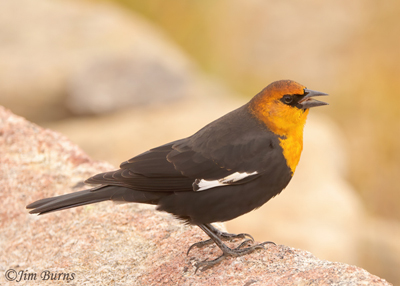Our three target birds for the trip, selected and prioritized by the recency of last sighting and the urgency to freshen my photo files, were Canada Jay, White-tailed Ptarmigan, and the rosy-finches, all montane species. One day toward the end of the trip we awoke to clouds and a forecast of rain. Grumpy at the dearth of any birds we had seen until then, we debated a day at the laundromat or catching up with world news and our email, but finally decided to go afield anyway.
Early afternoon found us sitting in our van at a pullout overlooking spectacular mountain peaks partially obscured by tendrils of rain, glacial tarns gleaming in the treeless tundra below us. We had hiked a ridge for the ptarmigans but found only Lark Sparrows. We had eaten lunch at a picnic table in a forested nook that looked perfect for jays, “camp robbers” known for their affinity at finding human leftovers, but had found . . . nothing. This high, rocky vista point looked possible for rosy-finches. We lingered.
Suddenly Deva exclaimed “Little bird with a yellow head, right there on the ground!” Excited by the possibility of anything with wings, I grabbed the camera and leaped from the vehicle without fully processing her spontaneous and succinct description. Slipping around the front of the van, I honestly had no idea what to expect, but I was pretty confident it would be a bird.
Let me set the scene for you. We were in alpine habitat at 12,000 feet of elevation. The temperature gauge read mid-40’s, but the wind chill was maybe low 20’s with the gusts straight off the peaks probably at 30 mph. The nearest trees were stunted and bowed Ponderosa Pine a quarter of a mile away, almost straight down. Dismayed by the turn the heretofore beautiful Rocky Mountain high weather had taken, we had just asked one another, “What bird in its right mind would be up here now?”
As it turned out, a Yellow-headed Blackbird, a male, was that bird! Not a little bird, but definitely one with a yellow head, so her hurried description was half right. Not a rosy-finch for sure, but what the heck was a bird of lakes and marshes typically found foraging in lowland agricultural settings doing up here in the tundra, in terrible, high montane weather, all by itself?
I snapped a few documentation images of the “best” bird of our trip before my fingers went numb in the cold, then jumped back into the van to warm up and speculate on how unlikely this sighting was. And why. You can supply your own speculation here, as well as your own definition of “best.” This sighting perfectly exemplifies the allure of birding.